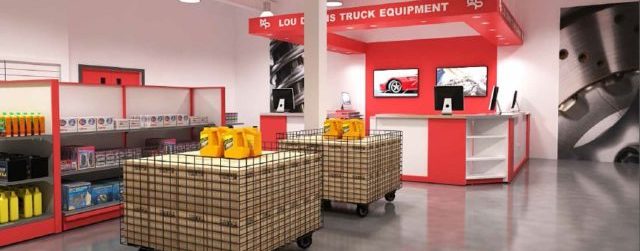Despite the effects that the pandemic has had on many aftermarket operations, a recent survey by NPD showed that do-it-yourself business is up markedly. This bodes well for shops with retail showrooms, but store design can have a real impact on performance.
However, it does mean that ensuring that showrooms are well prepared for anti-COVID measures, from mask-wearing to allowing enough space for social distancing, is imperative. He asked Paul Reed how store design – in terms of both newly designed showrooms and modifying existing ones – can help maximize safety and streamline cleaning procedures while making them more efficient, for both customers and staff.
“Some of the same principles that make for good store design, even in normal times, are good for COVID too,” Paul Reed, store design specialist and Jobber Nation contributor pointed out.
These include a clean, open design that allows customers to browse without having to get too close to staff or other customers; well-designed lighting, signage and traffic flow patterns that allow them to locate what they need, go to the counter to pay and get on their way quickly; and efficient, well-organized displays.
Freestanding gondolas hold a lot of product and yet are easy to stock and display products clearly. Baskets or bins on wheels are great for high-traffic items like washer fluid, gloves or even PPE, and can be wheeled to the back for quick restocking.
Even in a more open retail environment, good in-store safety practices are mandatory.
“Every store should have masks, hand sanitizer, and six-foot spacing between customers. If the store is very massive, with long counters, lots of gondolas, and is very busy, it should have clear direction and signage. If things are clearly labelled and displayed, people don’t need to wander around as much. Unfortunately, you want people in and out these days; it’s safer.”
Plexiglass barriers between customers and staff are another must; if customers tend to lean in and look at the counterperson’s computer, the counter can be designed to discourage that without seeming unfriendly. (Raising the height is one possibility.) In a large store with long counters, plexiglass dividers between multiple staff members are another option.
The waiting area is one section that often needs special attention, Reed says.
“We are working on a tire store in Montreal where we have to redesign the entire waiting area; it has WiFi stations that will have to be spaced out. But instead of a row of chairs, you could have chair, table, chair; and nowadays, many customers are choosing to drop off their vehicle and come back when it’s ready.”
Keeping a store not just clean, but sanitized, is crucial these days, and Reed talked about new technology available that goes far beyond the tried-and-true Lysol spray and paper towels.
“Many of our stores are fairly open, making it possible to install machines that spray the entire store at night and have it completely virus-free by morning. We also have autonomous UV machines that can sanitize the entire showroom [using light sweeps].”
Misting systems, which also are deployed at night when the store is closed, spread a thin cloud of electronics-safe germ killing solution over all exposed surfaces. And there are products that will safely clean sensitive items such as computer keyboards, drying in just a few seconds and protecting against viruses for 30 days.
However, Reed notes that UV light systems are highly effective at killing germs, but their one drawback is they can only kill what they can “see”; the beauty of a misting machine is that the spray spreads out into all areas, completely sanitizing the interior in just a few minutes.
Many store owners are concerned about the cost of retooling a whole store to make it easier to manage COVID cleaning and distancing procedures, especially given the overall challenges of the current economic climate.
“But if you compare it to the cost of having someone contract COVID in your facility, and having to shut down…” Reed pointed out. However, he continued, there are lower-cost alternatives such as smaller-scale spray units that are especially effective in high-touch areas.

What about non-public areas like stockrooms?
“There are autonomous units that can travel down aisles as little as 24” apart,” Reed pointed out. “And don’t forget, any stock that comes in should be sprayed as well.”
But overall, both in the showroom and the back areas, increasing open space is the secret to keeping retail spaces clean and safe, Reed explains.
“I understand you want to squeeze every inch you can out of the space – retail is very expensive – but spacing it out looks better and is safer for your customers.”
This content is based on the a webinar conducted as part of the Great Canadian Aftermarket Trade Show Virtual Event, operated by CHAT Integrated Media.


0 Comments